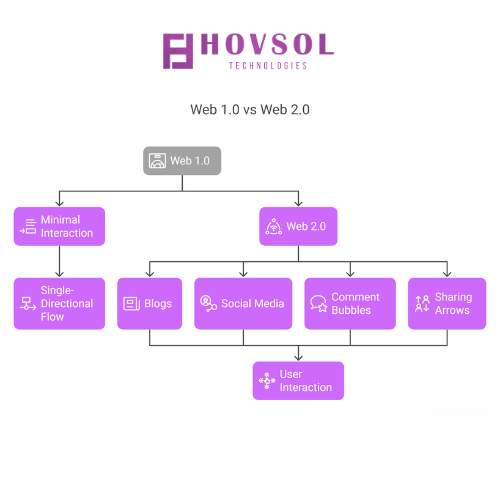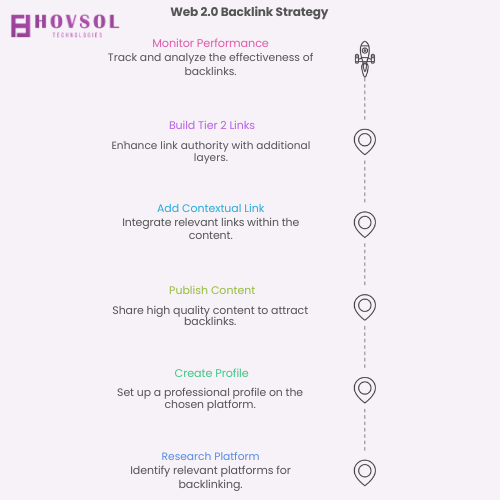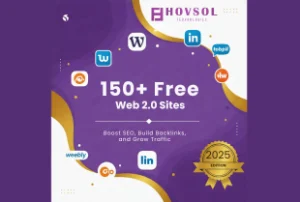Key Takeaways:
- Web 2.0 is still relevant for SEO in 2025, shifting from mass links to strategic content and presence.
- Focus on creating high-quality, relevant content directly on Web 2.0 platforms, treating them as extensions of your brand.
- Utilize Web 2.0 sites for building topical authority, driving targeted referral traffic, and diversifying your backlink profile naturally.
- Leverage Web 2.0 properties for tiered link building to strengthen your main site’s authority effectively.
The internet experienced a fundamental shift with Web 2.0, transforming from static pages into dynamic, interactive platforms driven by user participation. This revolution empowered individuals to become content creators, collaborators, and community builders. Think of the rise of social media, blogging platforms, wikis, and forums – all powered by the principles of Web 2.0.
As Eric Schmidt, former CEO of Google, aptly described it, “Web 2.0 is the turning of the web into a platform for interaction, not simply access.“
This transformation laid the groundwork for the digital landscape we navigate today, influencing everything from digital marketing strategies to software development. For anyone serious about online visibility in 2025, understanding and leveraging Web 2.0 platforms remains a crucial piece of the puzzle.
What is Web 2.0?
At its core, Web 2.0 describes websites where content is largely generated and shared by users. Unlike the static “read-only” sites of Web 1.0, Web 2.0 platforms encourage participation through features like comments, likes, shares, and the ability for users to publish their own articles, videos, images, and more.
For SEO, Free Web 2.0 sites offer potential avenues to:
- Increase brand visibility and reach.
- Establish topical relevance and authority.
- Potentially drive referral traffic.
- Build a diversified backlink profile (when used strategically).
- Engage with audiences in different online spaces.
Let’s clarify the distinction between the old and new web paradigms:
| Feature | Web 1.0 | Web 2.0 |
|---|---|---|
| Content | Static, read-only | Dynamic, User-Generated |
| Interaction | Limited (forms, email) | Rich (comments, shares, likes, collaboration) |
| User Role | Consumers | Creators, Collaborators, Participants |
| Technology | HTML, CSS | AJAX, APIs, JavaScript, RSS |
| Examples | Static personal pages | Social Networks, Blogs, Wikis, Forums |
| Focus | Information Dissemination | Participation, Community, Sharing |

Why Web 2.0 Still Matters for SEO in 2025
While SEO has become more sophisticated, free Web 2.0 platforms haven’t lost their potential value. Their benefits in 2025, however, are less about mass link acquisition and more about strategic integration and quality content creation on the platforms themselves.
Here’s why they can still be powerful tools:
- Establishing Presence & Reach: Having a presence on relevant Web 2.0 sites puts your brand and content in front of different audiences you might not reach otherwise.
- Topical Authority: By publishing high-quality, niche-relevant content on platforms like Medium or industry-specific blogging sites, you can build topical authority for your brand away from your main website.
- Driving Referral Traffic: A well-optimized piece of content on a popular Web 2.0 site can genuinely attract readers who then click through to your main site for more information. This is high-quality traffic.
- Diversified Backlink Profile: Links from a variety of reputable sources look more natural to search engines. Web 2.0 properties, especially those with high domain authority, can contribute to this diversity.
- Tiered Link Building Opportunities: Web 2.0 sites serve as excellent Tier 2 assets. You can build backlinks to your Web 2.0 pages to increase their authority, which can then potentially strengthen the link pointing to your main site (Tier 1).
- Control Over Content & Anchor Text: Unlike guest posting or link insertions on external sites, you have full control over the content and how you link back to your site on your own Web 2.0 properties.
However, simply creating profiles and dropping links will not work and can even be detrimental. The key in 2025 is strategy and quality.
How to Effectively Use Free Web 2.0 Sites for SEO in 2025
Maximizing the SEO value of Web 2.0 sites today requires a thoughtful approach. Forget old-school spamming tactics; focus on providing value
- Prioritize Quality Content: This is non-negotiable. Treat your Web 2.0 properties like mini-blogs or extensions of your main site. Publish unique, well-written, informative, and engaging content that is relevant to your niche and target audience. Thin or duplicate content will likely be ignored or penalized.
- Focus on Niche Relevance: Choose platforms and create content directly related to your website’s topic. A link from a relevant piece of content on a relevant platform is far more valuable than a link from unrelated, generic content.
- Craft Natural, Contextual Links: Embed links within the body of your content where they make sense logically. Use natural anchor text variations that fit the surrounding text, rather than always using exact match keywords. The link should add value for the reader.
- Build Out the Web 2.0 Property: Don’t just create one page and leave it. Add multiple posts, descriptions, images, and link internally within the Web 2.0 property to create a mini-site with some depth.
- Engage and Promote (Where Applicable): Some Web 2.0 sites have social features. Engage with others, share your Web 2.0 content, and try to drive traffic and interaction to the Web 2.0 property itself. This user engagement can signal quality.
- Diversify Your Strategy: Web 2.0s should be part of a broader SEO and link building strategy, not the entire strategy. Combine them with other methods like guest posting, broken link building, resource page links, etc.
- Consider Tiered Linking: Once your Web 2.0 property has quality content, you can build links to it from other sources (e.g., social media shares, directory mentions, lower-tier Web 2.0s). This can pass authority up to the Web 2.0, and then to your main site.
- Use High-Quality Visuals: Just like on your main site, images, videos, and graphics can make your content on Web 2.0 sites more appealing and shareable.
- Stay Active (But Don’t Obsess): Periodically update content or add new posts to your most valuable Web 2.0 properties to show they are active.

List of Top Free Web 2.0 Sites for SEO & Backlinks
Here is a list of commonly used free Web 2.0 platforms. Remember that Domain Authority (DA) and Page Authority (PA) are third-party metrics and can fluctuate, but they often indicate the general strength and trust of a domain. Focus on platform relevance and content quality first.
| S.No | Web 2.0 Sites | DA | PA | Primary Function Category |
|---|---|---|---|---|
| 1 | Blogger.com | 100 | 100 | Blogging |
| 2 | WordPress.com | 95 | 100 | Blogging |
| 3 | Sites.google.com | 88 | 100 | Website Builder |
| 4 | Weebly.com | 99 | 99 | Website Builder |
| 5 | Wix.com | 92 | 95 | Website Builder |
| 6 | Tumblr.com | 69 | 92 | Blogging / Microblogging |
| 7 | Medium.com | 90 | 87 | Blogging / Publishing |
| 8 | LiveJournal.com | 81 | 87 | Blogging |
| 9 | Penzu.com | 96 | 85 | Blogging / Journaling |
| 10 | Postach.io | 93 | 84 | Blogging |
| 11 | Svbtle.com | 95 | 82 | Blogging |
| 12 | Ghost.org | 93 | 80 | Blogging (Free Tier Available) |
| 13 | Strikingly.com | 98 | 79 | Website Builder |
| 14 | Jimdo.com | 94 | 78 | Website Builder |
| 15 | Webs.com | 62 | 78 | Website Builder |
| 16 | Yola.com | 92 | 77 | Website Builder |
| 17 | Zoho.com | 76 | 77 | Suite (Includes Blogging) |
| 18 | Bloglovin.com | 93 | 76 | Blogging Reader/Platform |
Download the complete sheet from the resource link below the table.

150+ WEB 2.0
Dive into the vast landscape of the internet with a curated collection of over 150 Web 2.0 resources. Explore a wealth of interactive platforms and dynamic online tools.
DownloadBeyond dedicated blogging platforms, remember other Web 2.0 types:
- Social Media: Social Media: Facebook, Twitter, LinkedIn (for sharing content and engaging, less for direct link building via profiles). To maximize your reach on these platforms, discover the best time to post on social media.
- Content Sharing: YouTube (video), SlideShare (presentations), Pinterest (images), SoundCloud (audio) – excellent for embedding content and getting referral traffic, sometimes with profile links.
- Forums & Q&A: Quora, Reddit (participate, share knowledge, link cautiously where appropriate and adds value, avoid spam).
- Community Platforms: Niche forums, online groups.
Overview of Free Web 2.0 Sites
Free Web 2.0 sites empower you to build an online presence and share your expertise without significant investment. Their user-friendly interfaces make content creation accessible to everyone.
For SEO in 2025, their value lies in:
- Accessibility: Easy creation of blogs, mini-sites, and multimedia content.
- Cost-Effectiveness: Free platforms reduce initial investment.
- SEO Potential: When used strategically with quality, relevant content, they can build authority, drive traffic, and support your link profile.
- Engagement Potential: Built-in social features can help connect with audiences.
Leveraging these platforms smartly is about extending your digital footprint and reinforcing your brand’s authority across multiple online spaces.
FAQs
Q. How exactly do Web 2.0 sites benefit SEO in 2025?
Beyond just potential backlinks, they help by increasing brand mentions, diversifying your online presence, allowing you to build topical authority on external platforms, creating assets for tiered link building, and potentially driving targeted referral traffic through valuable content. The key is quality content creation on the Web 2.0 site itself.
Q. What are some examples of popular Web 2.0 sites?
Popular Web 2.0 sites include Facebook, Twitter, YouTube, Google Docs, and Wikipedia—platforms that showcase interactive, user-driven content and real-time collaboration.
Q. How do businesses benefit from Web 2.0 sites?
Web 2.0 sites help businesses boost brand visibility, engage customers, and leverage user-generated content and targeted ads to build trust and drive growth.
Q. What is the difference between Web 2.0 and blog?
Web 2.0 refers to the broader evolution of the internet focused on user interaction, collaboration, and content sharing across platforms. A blog is a specific Web 2.0 tool where individuals or businesses publish regular content, often encouraging comments and discussions.
Q. How many links should I include on a Web 2.0 page?
Link naturally and sparingly. One or two relevant links back to your main site per article is usually sufficient. Ensure the anchor text is natural and the link provides value to the reader (e.g., linking to a source, a related guide on your site, a product mentioned). Avoid stuffing keywords into anchors.
Q. Are Web 2.0 sites good for tiered link building?
Yes, they are excellent for this. Once you've built out a Web 2.0 property with good content, you can build links to that Web 2.0 page from other sources (social media, directories, comments sections where appropriate, other lower-tier Web 2.0s). This strengthens the Web 2.0 page, which in turn can pass more authority to your main site.
Conclusion: Why Strategic Web 2.0 Use Still Matters Today (and in 2025)
As Tim O’Reilly, who popularized the term Web 2.0, noted,
“Web 2.0 is about harnessing collective intelligence and turning the web into a true platform for collaboration and innovation.“
In 2025, free Web 2.0 sites continue to offer opportunities to create, connect, and grow online. Whether you’re aiming to build topical authority, diversify your online presence, drive referral traffic, or support your link building efforts, these platforms provide accessible avenues.
The key isn’t merely having a list of sites, but understanding how to leverage them strategically by creating high-quality, relevant content on them. A strong, strategically built presence across select Web 2.0 platforms can complement your main website’s SEO efforts, build credibility, foster engagement, and contribute to sustainable organic growth.
Don’t just create profiles; create valuable content that reflects your brand’s expertise and adds value to the specific community on each platform. Leverage the power of these platforms smartly to amplify your digital footprint in 2025 and beyond!
If you found this guide helpful, don’t forget to share it across your favorite Web 2.0 platforms and help others supercharge their online journey!
Table of Contents
- Key Takeaways:
- What is Web 2.0?
- Let's clarify the distinction between the old and new web paradigms:
- Why Web 2.0 Still Matters for SEO in 2025
- How to Effectively Use Free Web 2.0 Sites for SEO in 2025
- List of Top Free Web 2.0 Sites for SEO & Backlinks
- Overview of Free Web 2.0 Sites
- Conclusion: Why Strategic Web 2.0 Use Still Matters Today (and in 2025)




